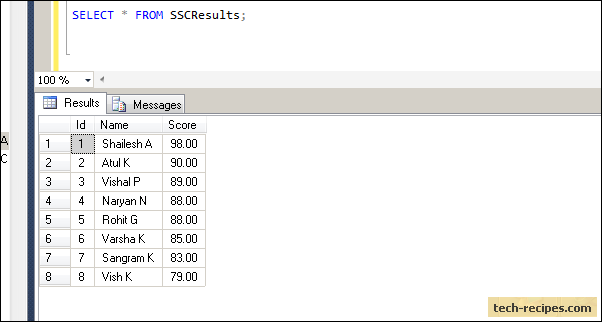For example, if an INSERT TRIGGER fires as the result of an INSERT statement that used a TOP clause. Because you can include the TOP clause in the view definition, certain rows may disappear from the view if the rows no longer meet the requirements of the TOP expression due to an update. Because the statement used TOP WITH TIES, it returned three more products whose list prices are the same as the third one. SELECT TOP is useful when working with very large datasets.

If you are using the TOP clause along with the ORDER BY clause, the TOP clause is applied to the ordered result set. Essentially, the select top method is used to find the min or max record for a particular column’s value. There is some debate as to whether this is the ‘correct’ method of querying, however it should be known that this method does not break any guidelines and is supported by all standards of SQL.
In some situations, you may not be interested in all of the rows returned by a query, for example, if you just want to retrieve the top employees who recently joined the organization, get top students by score, or something like that. Top -N queries ask for the n smallest or largest values of a column. Following this type of searching technique could save lot of time and complexities.
The TOP clause is used to specify the number of records to return. Returning a large number of records can impact on performance. Note: Not all database systems support the TOP clause.
The operation performed by TOP , LIMIT, and ROWNUM clause has almost the same functionality. Usually such queries are accompanied by ORDER BY clause. The rows referenced in the TOP expression used with INSERT, UPDATE, or DELETE are not arranged in any order. TOP n returns n random rows. The TOP filter is a proprietary feature in T- SQL , whereas the OFFSET-FETCH filter is a standard feature.
A FETCH clause will work for all. The top clause specifies that how many rows are returned. SQL DISTINCT and TOP in Same Query This article is inspired by a series of questions that one of my readers, Nan, recently sent me regarding DISTINCT, TOP , and ORDER BY.
Learn how to limit the SQL query result set to Top -N rows only when using Oracle, SQL Server, PostgreSQL or MySQL relational database systems. How to find TOP in each group ? Top SQL interview questions for tech professionals. Doing an SQL interview as part of your job application? Get some advance practice with our free sample questions. In the following script, I have used windows function and have listed top students from each class based on their marks.
You would need to provide the whole query to know the exact impact. Check out the description of the TOP clause in SQL Server Books Online for more information. However, that same pool could be a stunning place to be, full of refreshing water on a sunny day if you know how to swim.
Similarly, a huge database could be fun and useful if you know these most basic and simple queries of SQL. Research has proven that these queries are only of entire query set which can be formulated in SQL. The SQL TOP clause is used to limit the number of rows that are returned by a query. Usually, Databases, tables hold millions or billions of records. We can use the SQL TOP Clause and extract the required number of rows.

If you want to see the top products, there is no point in retrieving all the million records. SQL stands for Structured Query Language , and it is used to communicate with the Database. This is a standard language used to perform tasks such as retrieval, updation, insertion and deletion of data from a database. This clause is very useful while dealing with large databases. TOP is used to return a specific number of rows from a query result.
TOP isn’t ANSI compliant and its use manly limited to Microsoft products such as SQL Server and MS-Access. Despite a 4percent increase in processed documents over the past five years, we’re on top of that growth. We get a lot from SQL Server—reliability, scalability, integration, and agility. I want to get the top downloads by count for a given date range. Not being a strong SQL guy, can you guys give me a recommendation for a query to accomplish this?

I was looking for a good forum specifically for SQL so here I am. My question - How can I select the first n rows in a table, and how can I select the last n rows in a table.
Inga kommentarer:
Skicka en kommentar
Obs! Endast bloggmedlemmar kan kommentera.